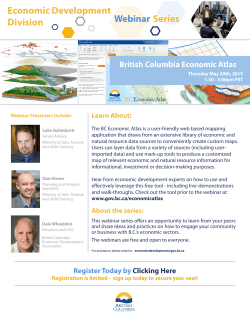
- Good evening - Those who know me
‐ Good evening Good evening ‐ Those who know me ‐ I have keen interest in Moon, not just observing & imaging but also history of man’s relationship with it ‐ Tonight talk about PHOTOGRAPHIC LUNAR ATLAS, hope to share appreciation for work by those who have gone before us h i ti f k b th h h b f 1 ‐ Serious telescopic study of Moon began shortly after Galileo Serious telescopic study of Moon began shortly after Galileo reported his observations in the early 17th century ‐ Up into the 20th century almost all lunar study involved mapping & naming of features, a field called Selenography ‐ Little or no research was done in all this time regarding the M Moon’s geology or how it was formed. ’ l h it f d ‐ In fact many scientists believed a large number of craters to be of volcanic origin right up until the late 20th century. 2 ‐ After WW2 the US increased research in rocketry and other After WW2 the US increased research in rocketry and other space sciences, dependent largely on the German scientists who immigrated after the war. ‐ Research at the time was not well organised and poorly funded ‐ This all changed when the Space Race was officially kicked off on Oct 4 O t 4th, 1957 with the USSR’s launch of Sputnik 1 1957 ith th USSR’ l h f S t ik 1 3 ‐ US President Kennedy was not about to loose the Space Race to the y p USSR ‐ His many speeches like the one we saw earlier tonight inspired Americans to the monumental task of putting a human on the Moon ‐ He also made sure that whatever funds were necessary were made available ‐ In his own words “... 4 ‐ With this new commitment to land a person on the Moon With this new commitment to land a person on the Moon before 1970, scientists and engineers were sent scrambling ‐ It was suddenly brought to light how little actual information we had about the Moon ‐ With less than 10 years to get it done, one of the first things th t h d t b d that had to be done was to learn as much as possible about the t l h ibl b t th physical makeup of the Moon ‐ Luckily funding was available to back the immense research effort that had begun 5 ‐This is where the main character in my story enters: Dr. Gerard P. Kuiper ‐ Wikipedia entry: “Kuiper, the son of a tailor in the village of Harenkarspel in North Holland, had an early interest in astronomy. He had extraordinarily sharp eyesight, allowing him to see magnitude 7.5 stars with the naked eye, about four times fainter than visible to normal eyes. He went to study at Leiden University in 1924, where at the time a very large number of astronomers had congregated. He befriended fellow students Bart Bok and Pi t O t h ff and was taught by Ejnar Pieter Oosterhoff d t ht b Ej H t Hertzsprung, Antonie A t i Pannekoek, P k k Willem de Sitter, Jan Woltjer, Jan Oort and the physicist Paul Ehrenfest. He received his B.Sc. in Astronomy in 1927 and continued straight on with his graduate studies. Kuiper finished his doctoral thesis on binary stars with Hertzsprung in 1933, after which he traveled to California to become a fellow under Robert Grant Aitken at the Lick Observatory. In 1935 he left to work at the Harvard College Observatory where he met Sarah Parker Fuller, whom he the Harvard College Observatory where he met Sarah Parker Fuller whom he married on June 20, 1936. Although he had planned to move to Java to work at the Bosscha Observatory, he took a position at the Yerkes Observatory of the University of Chicago and became an American citizen in 1937. In 1949, Kuiper initiated the Yerkes–McDonald asteroid survey (1950–1952).” 6 ‐ In 1960 Kuiper In 1960 Kuiper left the Univ. of Chicago to come to the Univ. Of left the Univ. of Chicago to come to the Univ. Of Arizona in Tuscon ‐ He came to Tuscon in search of more freedom in his research and to take advantage of the great observatories of the US S.W. ‐ Upon arrival he founded the Lunar & Planetary Laboratory, a community of scientists dedicated to solar system studies it f i ti t d di t d t l t t di including the Moon ‐ One of the first tasks for the LPL was to publish a comprehensive series of Lunar Atlases, the purpose of which was to give researchers a common basis for their lunar research 7 ‐ In all Kuiper In all Kuiper’ss group published 4 atlases: the namesake group published 4 atlases: the namesake Photographic Lunar atlas followed by four supplements, the last two being published in a single atlas. 8 ‐ The first atlas, called the Photographic Lunar Atlas, was The first atlas, called the Photographic Lunar Atlas, was published in 1960 ‐ It was a collection of lunar images from 44 fields covering the whole nearside face ‐ The images were collected from 1000’s of existing photographic plates from Mt. Wilson, Lick, Pic h t hi l t f Mt Wil Li k Pi du Midi, d Midi McDonald & Yerkes observatories between 1901 and 1959. ‐ the atlas was issued as a box of 212 17” x 21” black and white prints ‐ the large print size and number of fields was intended to encourage use of the atlas right at the telescope 9 ‐The The first supplement was called the Orthographic Atlas of the first supplement was called the Orthographic Atlas of the Moon ‐ It was also published in 1960, and it showed the best photos from the previous atlas with a rectangular grid overlaid to allow for the accurate location of features ‐ this atlas was published as a folio style book with 29 18” x 21” thi tl bli h d f li t l b k ith 29 18” 21” prints 10 ‐The The second supplement was called the Rectified Lunar Atlas second supplement was called the Rectified Lunar Atlas ‐ It was published in 1963, and showed images of the nearside of the Moon in 30 fields as viewed from directly overhead ‐ This was accomplished by projecting existing lunar photos onto a 3 foot diameter sphere and then re‐photographing from the appropriate position i t iti ‐ This atlas was published in a folio with 142 18” x 21” prints 11 ‐ The last two supplements were published in a single atlas The last two supplements were published in a single atlas called the Consolidated Lunar Atlas ‐ It was published in 1967 in the form of a boxed set of 227 17” x 21” prints ‐ The images for this atlas came from the systematic re‐ photographing of the Moon at higher resolution than achieved h t hi f th M t hi h l ti th hi d previously ‐ The work was performed by the LPL using the scopes at the Catalina and US Naval Observatories 12 ‐Kuiper’s lunar atlases were important because they provided a much needed foundation upon which other researchers could build hi h h h ld b ild ‐ In the course of publishing the atlases the LPL developed a number of new technologies including the method for rectifying lunar photos, as well as a number of different large format printing processes that were needed to accurately reproduce the detail found in the glass photographic plates the detail found in the glass photographic plates ‐ The lunar research that these atlases supported, as well as all the other work done by the LPL was instrumental in the success of the Apollo Program ‐ The atlas also resulted in some direct discoveries, the main one being the existence of the multi‐ring being the existence of the multi ring impact basin Mare impact basin Mare Orientale ‐ Surprisingly the atlas is still used frequently today as you will often see images from the Consolidated Lunar Atlas in Astronomy Magazine, on the Lunar Wiki or in other books and online articles. 13 ‐These These atlases are all long out of print, and finding used print atlases are all long out of print, and finding used print copies is very difficult; most are hidden away somewhere in university or professional observatory libraries. ‐ Electronic version of three of the atlases are available online at the links shown here ‐ I have been lucky enough to find print copies of two of the Ih b l k h t fi d i t i ft f th atlases, and I have had fresh copies made of the other two from the electronic versions...the reprints being about ½ size due to the high cost ‐ They are all available to look at in detail (during the break) 14 ‐ In Summary: I personally regard these atlases as an important In Summary: I personally regard these atlases as an important piece of history. They were published at a time when serious scientific study of the Moon was just beginning, and were an important stepping stone along the way to putting a person on the Moon. These atlases are also a reminder of the long h it heritage of discovery coming out of the LPL which continues to f di i t f th LPL hi h ti t this day. ‐Thank you 15
© Copyright 2025











